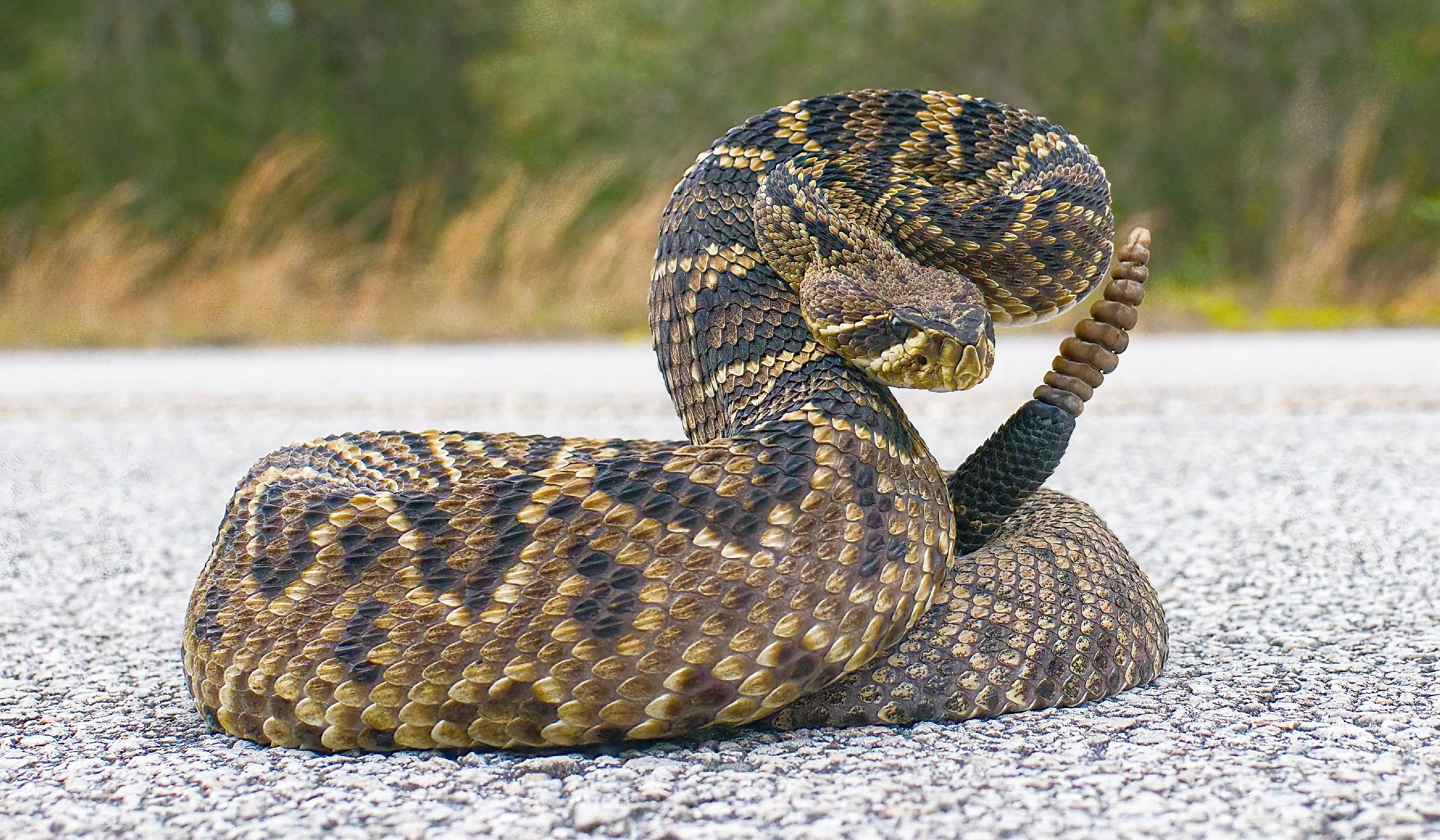
The Venomous Snakes Of Louisiana
Bordered by the Gulf of Mexico to the south, the warm, temperate climate of Louisiana isn’t just ideal for sunseekers and holidaymakers. Snakes love it, too. The deep south state is home to 47 native snake species, seven of which are venomous. Don’t let that change your travel plans, however. Most encounters with snakes pass peacefully. These fascinating critters just want to be left alone and will only strike when they feel threatened. Armed with the right information, you’ll know exactly where these snakes are found, how to identify them, and what to do if you see one in the wild. Read on for a guide to Louisiana’s venomous snakes so you can stay safe in the south and enjoy everything the Pelican state has to offer.
Eastern Coral Snake
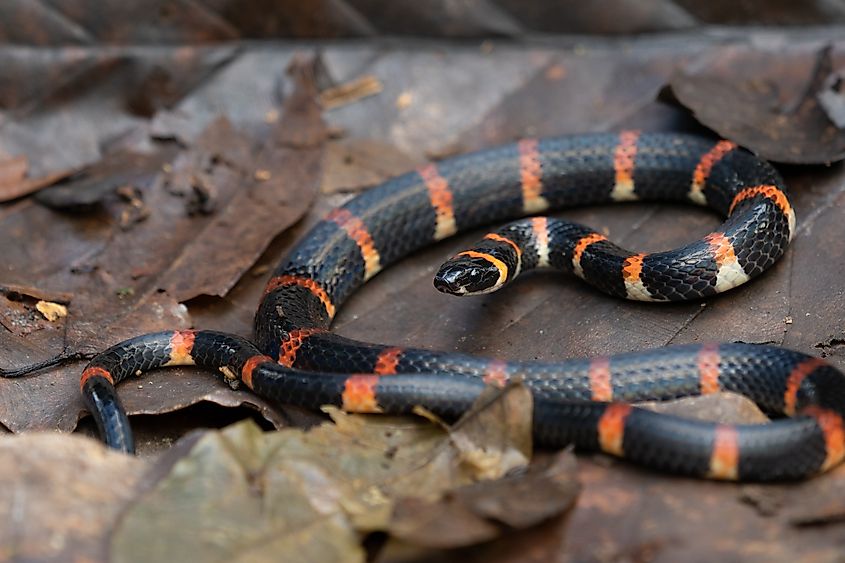
The Eastern Coral Snake, Micrurus fulvius, is also known as a Harlequin Coral Snake, thanks to its distinctive and colorful markings. The snake’s body is covered in black, yellow, and red rings, while its snout is black, and the back of its head is yellow. This striking pattern makes the snakes very easy to spot; however, they are often confused with non-venomous red and black snakes that look similar but aren’t as dangerous. Helpfully, there’s a rhyme to jog your memory; ‘Red touches yellow kills a fellow. Red touches black, venom lack’.
Eastern Coral Snakes are generally 2-3 feet long. When threatened, they tuck their head under their body and wave their tail in the air to confuse potential attackers. Their bite is highly venomous but they don’t strike so most bites occur when they are handled. Eastern Coral Snakes are also very shy — they prefer to remain concealed and sightings are extremely rare. The last known encounter in Louisiana was in the 1980s.
These snakes live in dry, wooded areas but can also be found in open pastures. They typically hunt in leaf litter on the forest floor, looking for lizards, small snakes, and rodents. Destruction of their habitats has led to a drop in population, and they’re listed as ‘imperiled’ in Louisiana.
Eastern Diamondback Rattlesnake
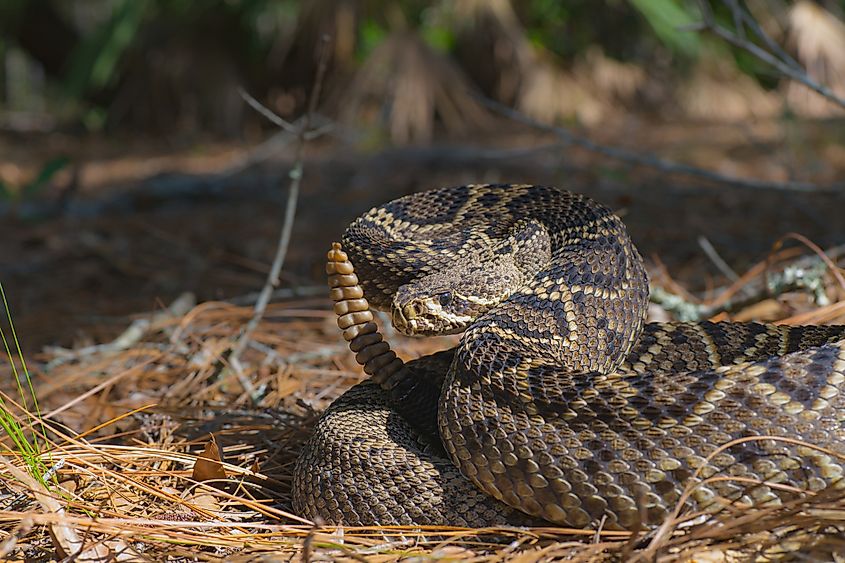
Crotalus adamanteus, or the Eastern Diamondback Rattlesnake, is the largest rattlesnake and the largest venomous snake native to the United States. Growing an average of 3-6 feet, this is a thick-bodied snake with dark diamond-shaped markings along its spine and a rattle at the end of its tail. You can also identify them from a dark stripe that runs from their eye to their jaw, and their wide head looks triangular when viewed from above.
The Eastern Diamondback Rattlesnake is ‘critically imperiled’ in Louisiana. There are few sightings in the wild but it has been spotted in open pineland north of Lake Pontchartrain, specifically in the Tangipahoa, Washington, and St. Tammany Parishes, also known as the ‘Florida Parishes’.
Like most snakes, this rattlesnake prefers to avoid conflict and will try to camouflage itself. If it is disturbed, it will coil up tightly, begin a warning rattle, and then eventually strike. Their typical diet is small rabbits and large rodents.
Southern Copperhead
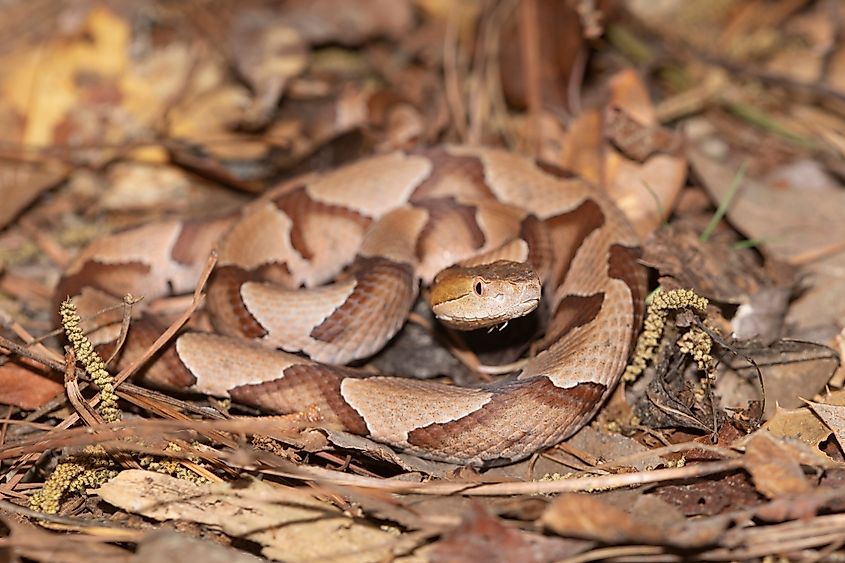
As the name suggests, the Southern Copperhead, or Agkistrodon contortrix contortrix, is found in the southern states, including in the woods and forests of Louisiana. This is a medium-sized snake, growing up to 4ft long and known for its copper or rust-like coloring on the top of its large, triangular head. The color of their body can vary slightly, ranging from light tan to pinkish-tan, and with hourglass-shaped dark brown to reddish-brown bands. Young Southern Copperheads have a distinctive yellow-tipped tail.
This snake mostly feeds on rodents, frogs, and cicadas. They generally stay camouflaged and can lie motionless for long periods of time, making it dangerous when walking the trails as you could easily step on or near them. When disturbed, the Southern Copperhead coils up and raises its head up from the ground. It may also vibrate its tail as a warning signal. Copperhead venom is rarely fatal as it is not very potent. However, if you are bitten, you should seek medical attention right away.
Texas Coral Snake
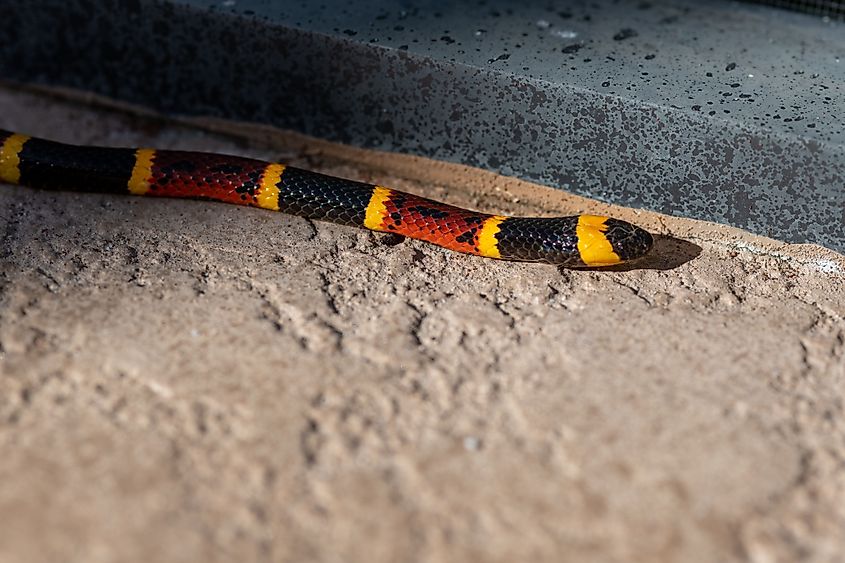
Micrurus tener may have been named for its home state, but it didn’t stay there. The Texas Coral Snake is also found in Arkansas and Louisiana. As with other Coral Snakes, these creatures are highly venomous and should be treated with great care.
Like its species mate, the Eastern Coral Snake, this snake is identified by its black, yellow, and red rings. The yellow rings are narrow, and the red rings may have speckles of black in them. Texas Coral Snakes are small, growing up to 3ft long. They’re secretive, preferring to stay concealed, and bite rather than strike and eat small rodents, lizards, and insects. These snakes are found in southwest, central and northern regions of Louisiana.
Timber Rattlesnake
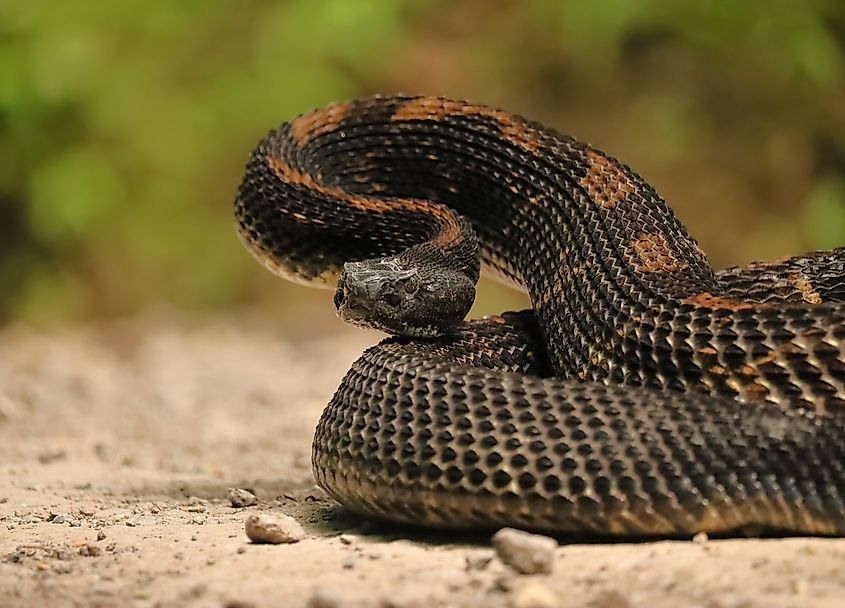
Also known as the Canebrake Rattlesnake, Crotalus horridus is found in almost every eastern state. Generally between 3 and 5ft long, this is a thick-bodied snake with a reddish-brown stripe down its spine and/or dark blotches along its back. They also have the tell-tale black rattle at the end of their tail, elliptical pupils, and large, triangular heads.
In Louisiana, the Timber Rattlesnake prefers woods and forests, especially hardwood habitats, but they can be found all over the state, except in coastal marshes. They’ve even been seen in the islands around Cote Blanche Bay and the highlands between Morgan City and Patterson in the south.
Timber Rattlesnakes prey on rodents, particularly wood rats and squirrels. They like to coil up near sheltered areas such as logs, thickets, or trees. Most encounters with this species occur during the change of seasons from spring to summer and fall to winter when the snakes are on the move, heading for foraging grounds or hibernation sites.
Western Pygmy Rattlesnake
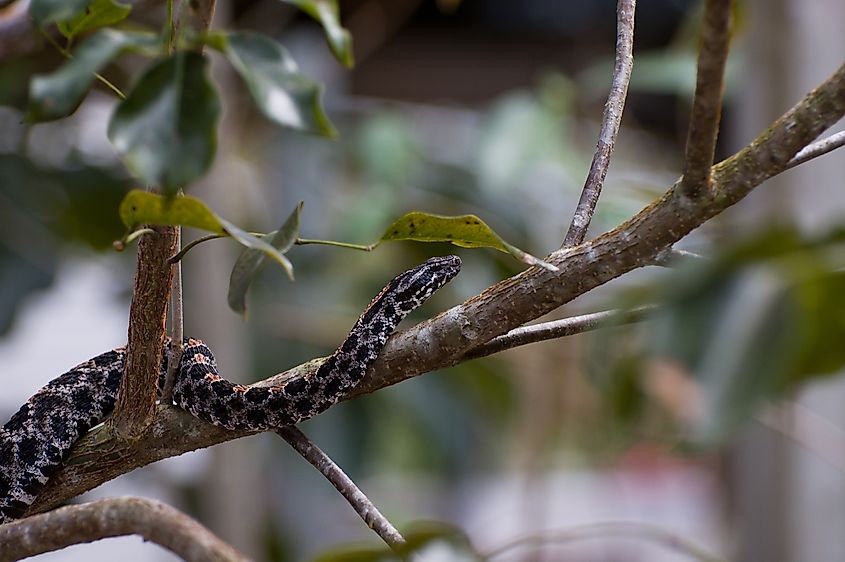
The Western Pygmy Rattlesnake, Sistrurus miliarius streckeri, is also referred to as a ‘ground rattler’. This small but venomous snake typically grows up to 2ft long and is pale grey, tan, or reddish with a reddish band down its back. These rattlers also have a cheek stripe, a black band that runs from their eye down to their jaw. Like other rattlesnakes, they have a wide, triangular head and elliptical pupils.
The Western Pygmy Rattlesnake’s rattle is not as impressive as larger rattlesnake species. In fact, it’s easy to miss it as the vibration sounds like a low buzzing, similar to the noise an insect makes. They feed on frogs, lizards, and other snakes,
Sistrurus miliarius streckeri is found in the Florida Parishes in eastern Louisiana, as well as northern and central parts of the state. Their preferred habitat is upland areas and pine flatwoods. They generally avoid swamps, sticking to grassy, dry, and wooded terrain. Encounters with Western Pygmy Rattlesnakes are rare in Louisiana, where they are listed as ‘imperiled.’
Western Cottonmouth
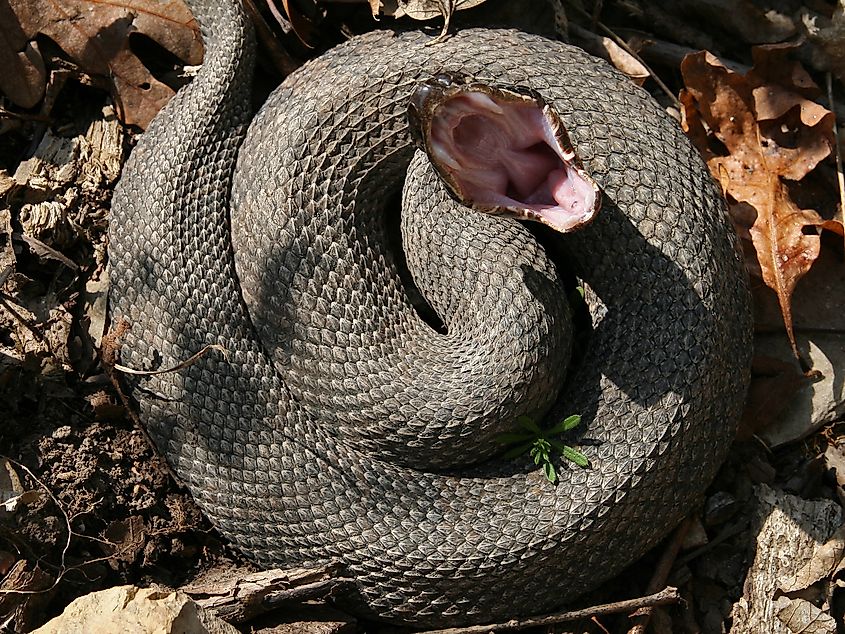
Agkistrodon piscivorus leucostoma, Water Moccasin, Western Cottonmouth — this venomous viper has several names and a scary reputation. When cottonmouths are threatened, they open their jaws wide, displaying their puffy white gums (from which they get their name). It may look aggressive, but this is just posturing on the part of the snake. They are warning you to keep your distance as they don’t want to attack. As with any snake, the best thing to do when encountering them is nothing. Just move out of its area and wait for it to leave.
Cottonmouths are found throughout Louisiana, typically in watery habitats such as swamps, ponds, lakes, and streams. They are relatively common with a stable population and eat fish, frogs, watersnakes, and small mammals. Western Cottonmouths are dark brown, black, or olive. They have dark, jagged bands around their body and a dark stripe along both sides of their head. Young snakes are brighter in color and have a yellow tip on their tail.
Humans have always had a rocky relationship with snakes, but that’s mostly down to misinformation and fear. Taking the time to learn about Louisiana’s venomous snakes will help you combat that fear and stay calm if you meet one. Most encounters happen between April and July. Snakes are active throughout the day in the spring months and the early mornings and evenings in summer as they tend to avoid the hot temperatures around midday.
If you see a snake, leave it alone. Back away slowly so the snake doesn’t feel threatened, and find an alternate route or wait for it to leave the area. If you are bitten, seek medical attention as soon as possible. The bottom line is that snakes don’t want to bite you and are not aggressive. They are a key part of the ecosystem, keeping rodent and insect populations in check and, in some cases, even cleaning up diseased fish to keep waterways healthy. With some knowledge about their habits and habitats, it’s possible for snakes and humans to happily coexist.











